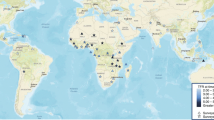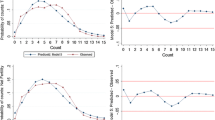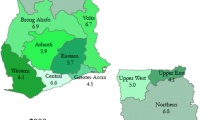Abstract
Social, cultural, and economic factors that influence fertility must work through the intermediate variables or proximate determinants that directly affect reproduction. This paper reviews the proximate determinants framework and recent advances in knowledge of its components. In addition, efforts to develop a comparable model for analysis of mortality are described. It is concluded that, for fertility, although gaps in knowledge of proximate determinants remain and continuing periodic measurement is necessary to monitor their levels and changes, the primary need now is to improve understanding of the causal links between the social and economic features of a population and the proximate determinants.
Similar content being viewed by others
References
1975 “A method for the estimation of fecundability.” Demography 12:645–660.
1978 “A framework for analyzing the proximate determinants of fertility.” Population and Development Review 4:105–132.
1980* “Does malnutrition affect fecundity? A summary of the evidence.” Science 208:564–569.
1982* “The fertility-inhibiting effects of the intermediate fertility variables.” Studies in Family Planning 13:179–189.
1983* “The proximate determinants of natural marital fertility.” In Rodolfo A. Bulatao and Ronald D. Lee with Paula E. Hollerbach and John Bongaarts (eds.), Determinants of Fertility in Developing Countries, Vol. 1: 103–138. New York: Academic Press.
Bongaarts, John and Hernando Delgado 1979 “Effects of nutritional status on fertility in rural Guatemala.” In Henry Leridon and Jane Menken (eds.), Natural Fertility: 107–133. Liege: Ordina Editions.
Bongaarts, John andJane Menken 1983 “The supply of children: A critical essay.” In Rodolfo A. Bulatao and Ronald D. Lee with Paula E. Hollerbach and John Bongaarts (eds.), Determinants of Fertility in Developing Countries, Vol. 1: 27–60. New York: Academic Press.
Bongaarts, John andRobert J. Potter, Jr. 1983 Fertility, Biology and Behavior: An Analysis of the Proximate Determinants. New York: Academic Press.
Bulatao, Rodolfo A. andRonald D. Lee 1983 “A framework for the study of fertility determinants.” In Rodolfo A. Bulatao and Ronald D. Lee with Paula E. Hollerbach and John Bongaarts (eds.), Determinants of Fertility in Developing Countries, Vol. 1: 1–26. New York: Academic Press.
Bullough, Vern L. 1981 “Age at menarche: A misunderstanding.” Science 213:365–366.
1985 “Strengths and limitations of the survey approach for measuring and understanding fertility change: Alternative possibilities.” In John Cleland and John Hobcraft (eds.), Reproductive Change in Developing Countries: Insights from the World Fertility Survey: 45–63. Oxford: Oxford University Press.
1986 “Routes to low mortality in poor countries.” Population and Development Review 12:171–220.
Caldwell, John C. andPat Caldwell 1983 “Demographic evidence for the incidence and course of abnormally low fertility in tropical Africa.” World Health Statistics Quarterly 36:2–34.
Caldwell, J., P. H. Reddy, andP. Caldwell 1983 “The social component of mortality decline: An investigation of South India employing alternative methodologies.” Population Studies 37:185–205.
Caldwell, P. andJ. C. Caldwell 1981 “The function of child-spacing in traditional societies and the direction of change.” In Hilary J. Page and Ron Lesthaeghe (eds.) Childspacing in Tropical Africa: 73–92. New York: Academic Press.
Casterline, John, Susheela Singh, John Cleland, andHazel Ashurst 1984 “The proximate determinants of fertility.” World Fertility Survey Comparative Studies No. 39. Voorburg, Netherlands: International Statistical Institute.
Chen, L. C., S. Ahmed, M. Gesche, andW. H. Mosley 1974 ”A prospective study of birth intervals in rural Bangladesh.” Population Studies 28:277–297.
Chowdhury, A. K. M. Alauddin 1978 “Effect of maternal nutrition on fertility in rural Bangladesh.” In W. Henry Mosley (ed.), Nutrition and Human Reproduction: 401–410. New York: Plenum Press.
Cleland, John 1985 “Marital fertility decline in developing countries: Theories and evidence.” In John Cleland and John Hobcraft (eds.), Reproductive Change in Developing Countries: Insights from the World Fertility Survey: 223–252. Oxford: Oxford University Press.
Cristescu, M., D. Petrovici, andM. Onofrei 1966 “Sur l'acceleration du developpement des caracteres sexuels secondaires.” Annuaire Roumain d'Anthropologie 3:65–70. Reported in Eveleth (1986).
Davis, Kingsley andJudith Blake 1956 “Social structure and fertility: An analytic framework.” Economic Development and Cultural Change 4:211–235.
Easterlin, Richard 1975 “An economic framework for fertility analysis.” Studies in Family Planning 6:54–63.
Eveleth, Phyllis B. 1986 “Timing of menarche: Secular trend and population differences.” In Jane B. Lancaster and Beatrix A. Hamburg (eds.), School-Age Pregnancy and Parenthood: Biosocial Dimensions: 39–52. New York: Aldine de Gruyter.
Eveleth, Phyllis B. andJames M. Tanner 1976 Worldwide Variation in Human Growth. Cambridge: Cambridge University Press.
Federation CECOS, D. Schwartz, andM. J. Mayaux 1982 “Female fecundity as a function of age.” The New England Journal of Medicine 306:404–406.
Foster, Andrew, Jane Menken, Alauddin Chowdhury, andJames Trussell 1986 “Female reproductive development: A hazards model analysis.” Social Biology 33:183–198.
Frank, Odile 1983 “Infertility in sub-Saharan Africa: Estimates and implications.” Population and Development Review 9:137–145.
1978 “Population, food intake, and fertility.” Science 199:22–30.
1985 “Maternal nutrition and lactational amenorrhea: Perceiving the metabolic costs.” In John Dobbing (ed.), Maternal Nutrition and Lactational Infertility: 65–91. Nestle Nutrition Workshop Series, Vol. 9. New York: Raven Press.
Frisch, R. E., G. Wyshak, andL. Vincent 1980 “Delayed menarche and amenorrhea in ballet dancers.” New England Journal of Medicine 303:17–19.
Garson, Lea Keil 1985 “The centenarian question: Old age mortality in the Soviet Union, 1897–1970.” Ph.D. dissertation, Princeton University.
Glasier Anna, Alan S. McNeilly, andPeter W. Howie 1984 “The prolactin response to suckling.” Clinical Endocrinology 21:109–116.
1985 “Estimation of fecundability from survey data.” Studies in Family Planning 16:252–259.
1987 “Variations in natural fertility: The effect of lactation and other determinants.” Population Studies 41:127–146.
Gray, Ronald 1983 “The impact of health and nutrition on natural fertility.” In Rodolfo A. Bulatao and Ronald D. Lee with Paula E. Hollerbach and John Bongaarts (eds.), Determinants of Fertitlity in Developing Countries, Vol. 1: 139–162. New York: Academic Press.
Habicht, J. P., Julie DaVanzo, W. P. Butz, andL. Meyers 1985 “The contraceptive role of breast-feeding.” Population Studies 39:213–232.
Hajnal, John 1965 “European marriage patterns in perspective.” In David V. Glass and David E. C. Eversley (eds), Population in History: 101–143. London: Aldine Publishing Company.
Hayflick, Leonard 1982 “Biological aspects of aging.” In Samuel H. Preston (ed.), Biological and Social Aspects of Mortality and the Length of Life: 223–258. Liege: Ordina Editions.
Henry, Louis 1972 On the Measurement of Human Fertility: Selected Writings of Louis Henry. Mindel C. Sheps and Evelyne Lapierre-Adamcyk, eds. and trs. New York: Elsevier Publishing Company.
Hertig, Arthur 1967 “The overall problem in man.” In K. Berirschke (ed.), Comparative Aspects of Reproductive Failure. New York: Springer-Verlag.
1982 “The effects of induced abortion on subsequent reproduction.” Epidemiologic Reviews 4:66–83.
1983 “Impact of vacuum aspiration abortion on future childbearing: A review.” Family Planning Perspectives 15:119–126.
Howie, Peter andAlan McNeilly 1982 “Effect of breast-feeding patterns on human births intervals.” Journal of Reproduction and Fertility 65:545–557.
Huffman, Sandra 1978 “Nutrition and postpartum amenorrhea in rural Bangladesh.” Population Studies 32:251–260.
Huffman, S., A. K. M. A. Chowdhury, andW. H. Mosley 1978 “Postpartum amenorrhea: How is it affected by nutritional status?” Science 200:1155–1157.
Huffman, S., K. Ford, H. Allen, and P. Streble 1985 “Nutrition and fertility in Bangladesh: Breastfeeding and postpartum amenorrhea.” Manuscript, The Johns Hopkins University.
Jain, A., A. Hermalin, and T. Sun 1979 “Lactation and natural fertility.” In Henri Leridon and Jane Menken (eds.), Natural Fertility: 149–194. Liege: Ordina Editions.
John, A. Meredith, Jane A. Menken, andA. K. M. Alauddin Chowdhury 1987 “The effects of breastfeeding and nutrition on fecundability in rural Bangladesh: A hazards-model analysis.” Population Studies 41:433–446.
Keyfitz, Nathan, ed. 1984 Population and Biology. Liege: Ordina Editions.
Knodel, John 1983 “Natural fertility: Age patterns, levels, and trends.” In Rodolfo A. Bulatao and Ronald D. Lee with Paula E. Hollerbach and John Bongaarts (eds.), Determinants of Fertility in Developing Countries, Vol. 1: 61–102. New York: Academic Press.
Kuhn, Thomas S. 1970 The Structure of Scientific Revolutions, 2d ed. Chicago: The University of Chicago Press.
Larsen, Ulla M. 1985 “Measures of sterility: A comparative study of the levels and the differentials of sterility in Cameroon, Kenya and Sudan.” Ph.D. dissertation, Princeton University.
Leridon, Henri 1977 Human Fertility: The Basic Components. Chicago: The University of Chicago Press.
Leridon, Henri andBenoit Ferry 1985 “Biological and traditional restraints on fertility.” In John Cleland and John Hobcraft (eds.), Reproductive Change in Developing Countries: Insights from the World Fertility Survey: 139–164. Oxford: Oxford University Press.
Lesthaeghe, Ron andFrank Elens 1987 “Production and reproduction in sub-Saharan Africa: An overview of organizing principles.” In Ron Lesthaeghe (ed.), Reproduction and Social Organization in sub-Saharan Africa. Berkeley: University of California Press.
Livi Bacci, Massimo 1987 Popolazione e Alimentazione: Tra Antagonismo e Adattamento; Saggio sulla storia demografica europea. Firenze: Universita degli Studi di Firenze.
Lunn, P. G. 1985 “Maternal nutrition and lactational infertility: The baby in the driving seat.” In John Dobbing (ed.), Maternal Nutrition and Lactational Infertility: 41–53. Nestle Nutrition Workshop Series, Vol. 9. New York: Raven Press.
Lunn, P. G., S. Austin, A. M. Prentice, andR. G. Whitehead 1984 “The effect of improved nutrition on plasma prolactin concentrations and postpartum infertility in lactating Gambian women.” American Journal of Clinical Nutrition 39:227–235.
Lunn, P. G. andR. G. Whitehead 1985 “Commentary.” In John Dobbing (ed.), Maternal Nutrition and Lactational Infertility: 19–20. Nestle Nutrition Workshop Series, Vol. 9. New York: Raven Press.
Makinson, Carolyn 1986 “Sex differentials in infant and child mortality in Egypt.” Ph.D. dissertation, Princeton University.
Malina, R. M., W. W. Spirduso, C. Tate, andA. M. Baylor 1978 “Age at menarche and selected menstrual characteristics in athletes at different competitive levels and in different sports.” Medicine and Science in Sports 10:218–222.
McDonald, Peter 1985 “Social organization and nuptiality in developing societies.” In John Cleland and John Hobcraft (eds.), Reproductive Change in Developing Countries: 87–114. New York: Oxford University Press.
McKeown, Thomas 1976 The Modern Rise of Population. New York: Academic Press.
McNeilly, Alan S., Anna Glasier, andPeter W. Howie 1985 “Endocrine control of lactational infertility. [Part] I.” In John Dobbing (ed.), Maternal Nutrition and Lactational Infertility: 1–16. Nestle Nutrition Workshop Series, Vol. 9. New York: Raven Press.
Menken, Jane 1975 “Estimating fecundability.” Ph.D. dissertation, Princeton University.
Menken, Jane, James Trussell, andUlla Larsen 1986 “Age and infertility.” Science 233:1389–1394.
Menken, Jane, James Trussell, andSusan Watkins 1981 “The nutrition-fertility link: An examination of the evidence.” The Journal of Interdisciplinary History 11:425–441.
Morris, Leo, Gary Lewis, Dorian L. Powell, John Anderson, Ann Way, Jeanne Cushing, andGregory Lawless 1981 “Contraceptive prevalence surveys: A new source of family planning data.” Populations Reports, Series M, No. 5:163–198. Baltimore, MD: The Johns Hopkins University.
Mosher, William D. andWilliam F. Pratt 1985 “Fecundity and infertility in the United States, 1965–1982.” NCHS Advance Data, No. 104. Washington, DC: Government Printing Office.
Mosley, W. Henry 1985 “Social determinants of infant and child mortality: Some considerations for an analytical framework.” In Frederic C. Shorter and Huda Zurayk (eds.), Population Factors in Development Planning in the Middle East: 120–136. New York: The Population Council.
Mosley, W. Henry and Lincoln C. Chen 1984 “An analytical framework for the study of child survival in developing countries.” In W. Henry Mosley and Lincoln C. Chen (eds.), Child Survival: Strategies for Research: 25–45. Supplement to Vol. 10, Population and Development Review.
Nathanson, C. A. 1984 “Sex differences in mortality.” Annual Review of Sociology 10:191–213.
National Center for Health Statistics, William D. Mosher, and William F. Pratt 1987 “Fecundity, infertility and reproductive health in the United States, 1982.” Vital and Health Statistics, Series 23, No. 14. Washington, DC: Government Printing Office.
Pebley, Anne R., Sandra L. Huffman, A. K. M. Alauddin Chowdhury, andP. W. Stupp 1985 “Intra-uterine mortality and maternal nutritional status in rural Bangladesh.” Population Studies 39:425–440.
Potter, Robert G. andMargaret P. Parker 1964 “Predicting the time required to conceive.” Population Studies 18:99–116.
Preston, S. H. 1975 “The changing relation between mortality and level of economic development.” Population Studies 29:231–248.
Robyn, Claude, Sylvain Meuris, andPhilippe Hennart 1985 “Endocrine control of lactational infertility. [Part] II.” In John Dobbing (ed.), Maternal Nutrition and Lactational Infertility: 25–36. Nestle Nutrition Workshop Series, Vol. 9. New York: Raven Press.
Romaniuk, Anatoly 1968 “Infertility in tropical Africa.” In J. C. Caldwell and C. Okonjo (eds.), The Population of Tropical Africa: 214–224. London: Langmans.
Salber, Eva, Manning Feinlieb, andBrian MacMahon 1966 “The duration of postpartum amenorrhea.” American Journal of Epidemiology 82:347–358.
Sheps, Mindel C. andJane A. Menken 1973 Mathematical Models of Conception and Birth. Chicago: University of Chicago Press.
Singh, Susheela andJohn Casterline 1985 “The socio-economic determinants of fertility.” In John Cleland and John Hobcraft (eds.), Reproductive Change in Developing Countries; Insights from the World Fertility Survey: 199–222. Oxford: Oxford University Press.
Tanner, James M. 1981 A History of the Study of Human Growth. Cambridge: Cambridge University Press.
Tekce, Belgin and Frederic C. Shorter 1984 “Socioeconomic determinants of child mortality and intermediary processes: Findings from a study of squatter settlements in Amman.” In W. Henry Mosley and Lincoln C. Chen (eds.), Child Survival: Strategies for Research: 257–280. Supplement to Vol. 10, Population and Development Review.
Tietze, Christopher 1957 “Reproductive span and the rate of reproduction among Hutterite women.” Fertility and Sterility 8:89–97.
Trussell, J. andC. Wilson 1985 “Sterility in a population with natural fertility.” Population Studies 39:269–286.
Vaessen, Martin 1983 “Childlessness and infecundity.” Unpublished manuscript, World Fertility Survey.
Waldron, Ingrid 1986 “What do we know about causes of sex differences in mortality? A review of the literature.” Population Bulletin of the United Nations 18-1985:59–76.
Watkins, Susan Cotts andJane Menken 1985 “Famines in historical perspective.” Population and Development Review 11(4):647–675.
Westoff, Charles F., James McCarthy, Noreen Goldman, andFelix Mascarin 1979 “Sterilization in Panama.” International Family Planning Perspectives 5(3):111–117.
Wyshak, Grace andRose E. Frisch 1982* “Evidence for a secular trend in age of menarche.” New England Journal of Medicine 306:1033–1035.
Author information
Authors and Affiliations
Rights and permissions
About this article
Cite this article
Menken, J. Proximate determinants of fertility and mortality: A review of recent findings. Sociol Forum 2, 697–717 (1987). https://doi.org/10.1007/BF01124381
Issue Date:
DOI: https://doi.org/10.1007/BF01124381




